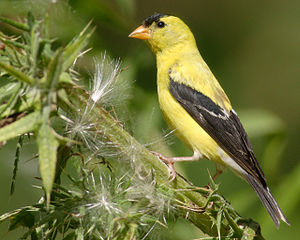American Goldfinch Carduelis tristis
Order: PASSERIFORMES Family: Finches (Fringillidae)
 The male goldfinch is a small, bright yellow finch with a black cap, wings, and tail, and white rump and undertail coverts. Females are duller with olive back and lacks black cap. Winter males will turn olive-brown with yellow shoulder bars, white wing bars, dark bill, and may show black on forehead and yellow on throat and face. Winter females are duller with buff wings and shoulder bars, and lack yellow and black on face and head. Juveniles resemble winter females but have a yellow wash on throat and breast.
The male goldfinch is a small, bright yellow finch with a black cap, wings, and tail, and white rump and undertail coverts. Females are duller with olive back and lacks black cap. Winter males will turn olive-brown with yellow shoulder bars, white wing bars, dark bill, and may show black on forehead and yellow on throat and face. Winter females are duller with buff wings and shoulder bars, and lack yellow and black on face and head. Juveniles resemble winter females but have a yellow wash on throat and breast.
.
Order: PASSERIFORMES Family: Finches (Fringillidae)
 The male goldfinch is a small, bright yellow finch with a black cap, wings, and tail, and white rump and undertail coverts. Females are duller with olive back and lacks black cap. Winter males will turn olive-brown with yellow shoulder bars, white wing bars, dark bill, and may show black on forehead and yellow on throat and face. Winter females are duller with buff wings and shoulder bars, and lack yellow and black on face and head. Juveniles resemble winter females but have a yellow wash on throat and breast.
The male goldfinch is a small, bright yellow finch with a black cap, wings, and tail, and white rump and undertail coverts. Females are duller with olive back and lacks black cap. Winter males will turn olive-brown with yellow shoulder bars, white wing bars, dark bill, and may show black on forehead and yellow on throat and face. Winter females are duller with buff wings and shoulder bars, and lack yellow and black on face and head. Juveniles resemble winter females but have a yellow wash on throat and breast..
The American Goldfinch is a bird of many aliases: wild canary, yellowbird, lettuce bird, and thistle bird, just to name a few. Ask a gardening enthusiast and you might hear the name “lettuce bird” due to the bird’s practice of nibbling at the tender young leaves of this vegetable. The American goldfinch looks similar to a canary at a pet store and so sometimes is called "wild canary" or "yellowbird".
.
.
Another descriptive name, is “thistle bird.” It has long been known that thistle plants and goldfinch are almost inseparable, and even its genus name, Caruelis, is from the Latin word carduus, meaning “thistle.” Goldfinches rely heavily on thistle plants as a source of food and for nest-building materials. A research study in Michigan observed Goldfinches always liked to nest near an abundant supply of thistle seed. If you want goldfinch to nest in your yard you can offer cotton nesting material too.
 Image via Wikipedia
Image via Wikipedia
Category ›
Question of the week
 Unknown
Unknown
 Wednesday, July 28, 2010
Wednesday, July 28, 2010










No comments:
Post a Comment